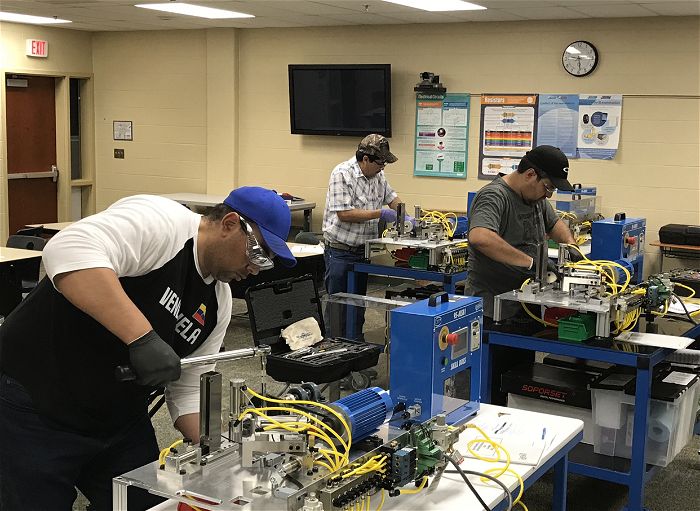
Bilingual Training Can Lead to Equitable Economic Recovery
July 13, 2020
At a Glance
With the nation facing an urgent need to redesign workforce and education systems, an innovative program called GOAL can serve as a model that inspires bold leaders to take a new approach to job training.
At this unprecedented moment, people are demanding change as the country confronts the health and economic crises produced by the COVID-19 pandemic and protesters are taking action to confront systemic racism. Together they reveal that systems in the U.S. are not “broken”— they are working as they were originally designed and intended to benefit a few at the top.
Grim statistics underscore the urgent need to reform and radically redesign (not simply fix) the U.S. health care, workforce, and education systems: Before the COVID-19 pandemic, the U.S. Department of Labor (DOL) had never recorded a single week of jobless claims over 1 million. Unemployment claims have now topped that for a consecutive 14 weeks. As of early June, more than a quarter of the U.S. labor force had filed new claims for unemployment benefits since COVID-19 first upended the economy in mid-March. And it’s clear that the pandemic has disproportionately hurt women, people of color, and immigrants, many of whom work in low-wage jobs and are overrepresented in retail and other frontline industries, and in sectors hit hard by the shutdown, such as hospitality.
Working for an Equitable Economic Recovery
At JFF, we’re calling on business, education, and government leaders to recognize that this moment of crisis represents an opportunity to reimagine and transform our education and workforce systems and launch an equitable economic recovery that benefits vulnerable workers and families.
This work will take place on many fronts. One way to start is to build upon innovative initiatives that have already proved successful in the field—especially job training programs that benefit English language learners (ELL), and in particular native Spanish speakers. According to U.S. Census Bureau projections, the country’s Hispanic population is expected to reach about 106 million in 2050, so taking steps now to expand instructional opportunities for Latinx workers will pay long-term dividends.
Bilingual Training Creates More Opportunity
One example of such an initiative is a program called GOAL (Growing Opportunities in America for Latinos). Designed to give workers with limited English an opportunity to develop the skills required for good manufacturing production jobs, GOAL combines English language instruction with a Spanish-language version of the coursework and assessments for the Manufacturing Skill Standards Council’s (MSSC) Certified Production Technician (CPT) certification.
Piloted in Indiana, GOAL allows Latinx workers to demonstrate what they’ve learned in their native language; a deviation from the detrimental “English only” mentality in the classroom that has been shown to have negative psychological effects for those not proficient in English. The bilingual model opens up opportunities for many more people. They can earn a credential, advance in their careers, and earn more money.
Students in the GOAL program work on the four modules that make up the CPT certification. Successfully completing just one module can help workers move up and gain essential skills that are crucial in all sub-industries of the manufacturing sector, and it has been demonstrated that the entire certification has incredible market value. In a recent study, the National Student Clearinghouse analyzed MSSC outcome data of 63,000 certificants over the six-year period of 2014-2019. Significant wage growth was found: Students who earn the MSSC Safety Certificate start earning about $20,000 the first year and progressively increase their wages with each additional CPT certificate. This results in an earning potential within five years of nearly $45,000 a year for students who pass all four modules and receive full CPT Certification.
In a recent case study, JFF identified promising practices of the GOAL program that organizations and employers should consider adopting if they set up bilingual training programs of their own. The recommendations include, in part:
- Ensure that translations of course materials and tests are accurate.
- Staff the program with bilingual teachers who can support contextualized English language learning.
- Before students enroll in the program, give them an opportunity to take classes in which they learn career-readiness skills and review basic math and reading—in English, Spanish, or both.
This moment has created an opportunity to overhaul the U.S. education and workforce systems so that they no longer reinforce inequality.
Before COVID-19 caused widespread job losses, bilingual manufacturing training programs like GOAL offered limited English proficient (LEP) individuals on-ramps to rewarding careers. Good jobs were available because there was a labor shortage and employers were struggling to find qualified workers. Many manufacturers had identified hiring and developing people from LEP populations as an effective way to build talent pipelines. Indeed, in a 2005 study conducted by the U.S. Department of Labor’s Employment and Training Administration, small and midsize manufacturers predicted that future pools of managerial candidates would be made up of current workers with limited English proficiency.
Now that unemployment rates are soaring, programs like GOAL will still play an important role (particularly with its equity focus), even though employers are no longer facing a labor shortage. Enrollment in education and training programs tends to increase during times of high unemployment. However, while education is often touted as the key to economic mobility, the U.S. postsecondary system can sometimes reinforce inequality because college is out of reach for many people.
This moment has created an opportunity to overhaul the U.S. education and workforce systems so that they no longer reinforce inequality. With its promising practices and initial track record of success, the GOAL program can serve as a model that inspires bold leaders to take a new approach to training—one that is more equitable and more inclusive. The opportunity to seize this moment and make the structural changes that will dramatically shift outcomes for people of yet unrealized talent is upon us.
Related Content

Growing Opportunities in Manufacturing through Bilingual Upskilling
The bilingual GOAL training program provides opportunities for English Language Learners to progress in advanced manufacturing careers. The bilingual GOAL training program provides opportunities for English Language Learners to progress in advanced manufacturing careers. This…

Working Together on Worker Training
Working Together on Worker Training This issue brief for Workforce Innovation Networks (WINs) addresses the advantages of inter-firm cooperation in meeting workforce development needs. Particularly for smaller companies, inter-firm cooperation can improve pre-employment skill development…

Apprenticeship & Work-Based Learning
Expanding and creating access to high-quality apprenticeship and work-based learning. Apprenticeship, pre-apprenticeship, and work-based learning are proven models for supporting economic advancement for workers, but many employers struggle to implement high-quality programs. And despite significant…